Top Photo: Sawfly larva or caterpillar?
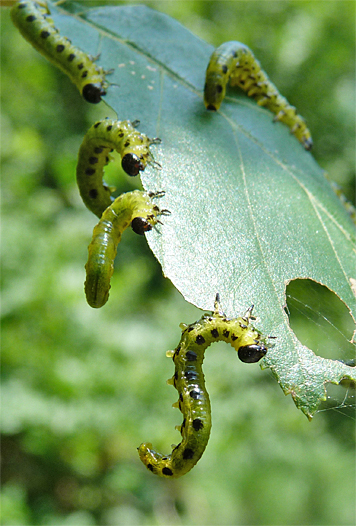
I received an email, with a blurry photo attached, stating that the emailer had taken the photo in Explore the Wild. The subjects in the photo looked to be caterpillars, but may have been sawflies, I couldn’t tell. I had to go look for myself.
The email said that the caterpillars, or whatever they were, were on a birch tree on the north side of the Wetlands. There are three birches on the north side of the Wetlands. It didn’t take me long to find the critters as they had eaten many leaves. Once in view, I knew that the larvae were sawflies. Sawflies feed together in groups and they tend to suddenly rear up and form an “S” or hook shape when disturbed. As soon as I poked the branch the whole lot of them sprung into action and held the pose.
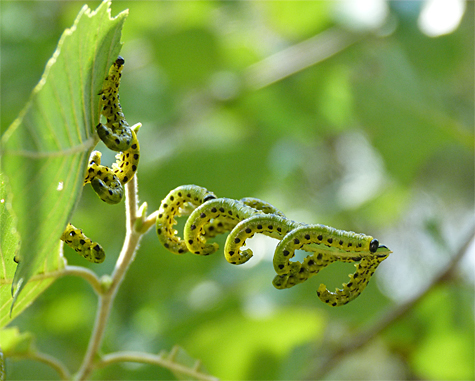
But, there are caterpillars that feed together like sawfly larvae and they also rear up and even flail about much like sawflies. So what’s the difference?
Sawflies belong to an order of insect called Hymenoptera which also includes ants, bees, and wasps. Butterflies and moths, whose larvae are called caterpillars, belong to an order called Lepidoptera.
We all know that insects, all of them, have six legs, right? But the larvae of some insects often have more than six legs, like caterpillars and sawfly larvae. The extra legs (prolegs) are only temporary, only there during the larval stage of life and help the larvae get from one place to another, and hold on to that place once they get there.
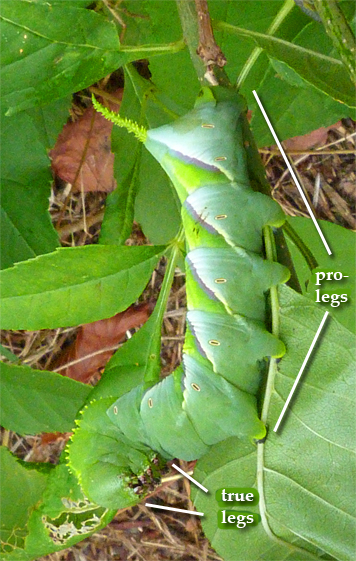
Imagine if the caterpillar in the above photo, a rustic sphinx moth and about four inches long at the time of the photo, had only those tiny true legs to grasp onto leaves, stems or branches. It would probably fall to the ground. The prolegs add extra strength and support.
Well, sawfly larvae have prolegs too. Besides the three pairs of true legs up near the head (on the thorax) they also have at least six pairs of prolegs.
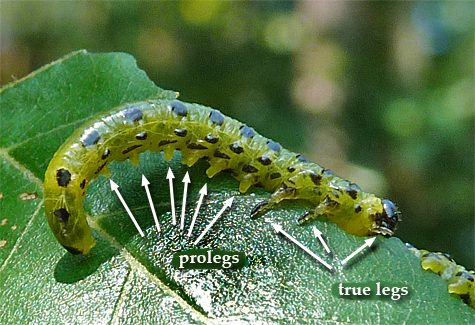
Butterflies and moths have five or fewer pairs of prolegs.
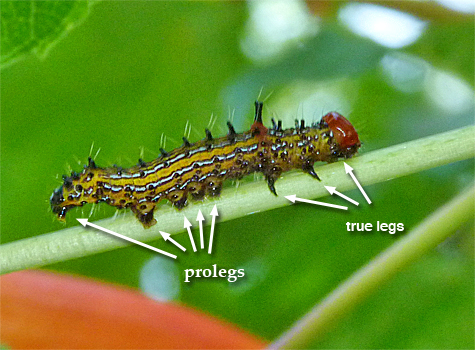
Red-humped caterpillars also feed in groups like the sawflies. And, red-humpeds may also raise up their rear ends in unison when disturbed. So, the best way to tell if you’re looking at a moth or butterfly caterpillar or sawfly larva is to count the pairs of prolegs, five or less and it’s a butterfly or moth caterpillar, six or more and it’s a sawfly larva.
And that’s the difference!

By the way, if you were wondering what the sawflies look like all grown up, here’s a photo on the right. I wasn’t able to find a dusky birch sawfly for the photo so you’ll have to settle for a hibiscus sawfly, they are very similar, except for the red mark.
I’ll see you in the Wild!

Mr. Ranger: What do the adult sawflies eat?
Good question. I had assumed that the adults visited flowers to nectar. Many bees, wasps and other members of the order hymenoptera do nectar on flowers. However, although I couldn’t find anything in the literature specific to dusky birch sawflies (Craesus latitarsus) I did find this on Idaho State University’s web site, “Adults of the family Tenthredinidae prey on insects visiting flowers and are known to pollinate those plants while hunting.” Dusky birch sawfly belongs to that family of sawfly, Tenthredinidae, so perhaps they are carnivorous. And, according to the above statement, they are important pollinators through the act of their hunting on various flowers, picking up pollen on one flower and delivering it to another while on the hunt.
Here’s ISU’s URL in case you want to look into this further http://www.isu.edu/~fultjess/Pollinators/Wasps.html
I’m certainly no expert on sawflies so if there’s anyone out there that can expand on the above please do so. Also, if anyone has witnessed dusky birch sawfly consuming prey, or nectaring, please contact me with your observations.
Thanks,